Abstract
In this review, we summarize recent studies on nuclear matter and finite nuclei based on parity doublet models. We first construct a parity doublet model (PDM), which includes the chiral invariant mass of nucleons together with the mass generated by the spontaneous chiral symmetry breaking. We then study the density dependence of the symmetry energy in the PDM, which shows that the symmetry energy is larger for smaller chiral inavariant mass. Then, we investigate some finite nuclei by applying the Relativistic Continuum Hartree–Bogoliubov (RCHB) theory to the PDM. We present the root-mean-square deviation (RMSD) of the binding energies and charge radii, and show that MeV is preferred by the nuclear properties. Finally, we modify the PDM by adding the isovector scalar meson , and show that the inclusion of the enlarges the symmetry energy of the infinite nuclear matter.
1. Introduction
Spontaneous chiral symmetry breaking plays an important role in low-energy hadron physics, contributing substantially to the generation of hadron masses and the manifestation of mass differences between chiral partners. In recent decades, there has been a growing focus on investigating the restoration of chiral symmetry in hot and dense matter. Nucleon masses will be changed in such extreme conditions, which provides hints for us towards a further understanding to the mass of hadrons and further understanding to the dynamics of the strongly interacting matter.
In the traditional linear sigma model, the entire nucleon mass is generated from the spontaneous chiral symmetry breaking, in which the chiral partner to ordinary nucleon is the nucleon itself. When the chiral symmetry is restored, the nucleon and its chiral partner will be degenerate in mass. However, increasing evidence from the lattice calculations [1,2] show that, with increasing temperature, the mass of negative parity baryon decreases to be degenerate with the mass of positive baryon at the critical temperature.
The Parity Doublet Model (PDM) was proposed in Ref. [3] as an extended linear sigma model with parity doubling structure to model the parity doubling of nucleon. In the PDM, the excited nucleon, such as , is regarded as the chiral partner to the ordinary nucleon, in which the spontaneous symmetry breaking generates the mass difference between them. By considering the symmetry properties of the chiral partner, the PDM predicts that the masses of the parity partners are degenerate into a finite mass, the so-called chiral invariant mass , when the chiral symmetry is restored. In addition to the lattice simulations mentioned above, a recent analysis based on the QCD sum rules [4] also supports the existence of the chiral invariant mass. Therefore, quantitative and qualitative study of the chiral invariant mass will help us to understand the origin of hadron masses.
Studying the chiral invariant mass is an essential measure to the origin of the mass of a nucleon. There are several analyses to determine the value of by studying the nucleon properties in vacuum. For example, the analysis in Ref. [5] shows that is smaller than 500 MeV using the decay width of , while Ref. [6] includes higher derivative interaction, which makes the large consistent with the decay width.
Chiral symmetry is expected to be partially restored in the high density region, the study of which will provide some information on the chiral invariant mass. Actually, the PDM is applied to study high density matter in several analyses, such as in Refs. [7,8,9,10,11,12,13,14,15,16,17,18,19,20,21,22,23,24,25,26,27,28,29,30,31,32,33,34,35,36,37,38,39,40]. Recently, in Refs. [33,35,37,38,40], the EoS of neutron star (NS) matter constructed from an extended PDM [19] was connected to the one from the NJL-type quark model, following Refs. [41,42]. The analysis of Ref. [33] used the observational data of NS given in Refs. [43,44,45,46,47,48] to put a constraint on the chiral invariant mass as 600 MeV MeV, which was updated in Refs. [37,38] to 400 MeV MeV by considering the effect of anomaly, as well as new data analysis [49,50,51]. Ref. [40] showed that MeV with the consideration of central compact object (CCO) within the supernova remnant HESS J1731-347 [52].
In recent decades, increasing attention is paid to the effect of isovector-scalar (980) meson (also called the meson) on asymmetric matter such as NS because it accounts for the attractive force in the isovector channel. References [53,54,55,56,57,58,59,60,61,62,63] use Walecka-type relativistic mean-field (RMF) models, and Refs. [64,65] use density-dependent RMF models to study the effect of (980) meson to the symmetry energy as well as to the EoS of asymmetric matter. It was pointed that the existence of meson increases the symmetry energy [53,55,56,59,60,61,62,63], and that it stiffens the NS EoS [54,55,56,58,59] and asymmetric matter EoS [65]. Therefore, the meson is influential for the study of asymmetric matter. Recently, in Ref. [66], the effect of in neutron star is studied in the PDM and the constraint to the chiral invariant mass is obtained as 580 MeV MeV. In particular, this work shows that the meson has large influence to the symmetry energy at density larger than saturation density. Therefore, it is expected that further experimental constraints on the symmetry energy will provide hints to the chiral invariant mass and the origin of the mass of a nucleon.
To put an additional constraint on the value of the chiral invariant mass, the properties of stable nuclei were studied in Ref. [67] with the PDM in the frame work of a self-consistent relativistic mean field theory. For the nuclear structure calculations, the Relativistic Continuum Hartree–Bogoliubov (RCHB) theory [68] was employed. It was found in Ref. [67] that the calculated binding energies and charge radii of selected fifteen nuclei are closest to the experimental values when MeV.
In this review, we summarize the recent works on the study of chiral invariant mass in infinite nuclear matter in Ref. [66] and finite nuclei in Ref. [67]. In Section 2.1, we introduce a PDM including meson based on the chiral U(2)L × U(2)R symmetry with U(1)A anomaly included. Then, as a first step, we drop the meson and construct the infinite nuclear matter using mean field approximation in Section 2.2, Section 2.3 and Section 2.4. In Section 3, the construction of finite nuclei in mean field model using Relativistic Continuum Hartree–Bogoliubov (RCHB) theory is introduced. After a brief introduction on the construction of finite nuclei, the finite nuclei are constructed using PDM, as in Ref. [67], and the method to constrain the value of chiral invariant mass using experimental data of finite nuclei are discussed. Some results on the specific nuclei, such as the nuclei properties and effective mass of a nucleon in finite nuclei, are also shown. In Section 4, we review an extension of the PDM by including the isovector scalar meson performed in Ref. [66]. We also compute the results for the extended PDM without vector meson mixing interaction for comparison. The symmetry energy for these models are compared to the PDM without meson introduced in Section 2. Finally, a summary is given in Section 5.
2. Dense Nuclear Matter with Parity Doublet Model
2.1. A Parity Doublet Model with U(2)L × U(2)R Symmetry
Here, we introduce the parity doublet model (PDM) based on the U(2)L × U(2)R chiral symmetry constructed in Ref. [66]. The Lagrangian is given by
where is for the nucleons, for the scalar and pseudoscalar mesons and for the vector mesons.
In , the scalar meson field M is introduced as the representation under the SU(2)L × SU(2)R × U(1)A symmetry, which transforms as
where and . We parameterize M as
where are fields for the sigma meson, pions, the lightest isovector scalar meson and meson, respectively, and are the Pauli matrices. The vacuum expectation value (VEV) of M is
where is the VEV of the field, which is equal to the pion decay constant MeV in vacuum. The explicit form of the Lagrangian is given by
where is the potential for M. In the present model, is taken as [66]
where we included all the terms invariant under SU(2)L × SU(2)R × U(1)A symmetry up to the sixth order in M fields. The six-point interaction terms are introduced to reproduce the nuclear saturation properties following Ref. [19]. The term proportional to is the explicit chiral symmetry breaking term due to the non-zero current quark masses, which generates the mass of pion. The last term is introduced to account for the U(1)A anomaly.
For vector mesons, the iso-triplet meson and iso-singlet meson are included based on the hidden local symmetry (HLS) [69,70,71] to account for the repulsive force in the hadronic matter. The HLS is introduced by performing polar decomposition of the field M as
where is the matrix field for scalar mesons. The fields transform as
with and . Here, for and for . In the unitary gauge of the HLS, are parameterized as
where is the matrix field for pseudoscalar mesons. In the HLS, vector mesons are introduced as the gauge bosons of the HLS. They transform as
where and are the gauge fields for SU(2)HLS and U(1)HLS, respectively, and and are the corresponding gauge coupling constants.
To construct the Lagrangian invariant under the HLS, it is convenient to define the covariantized Maurer–Cartan 1-forms:
where the covariant derivatives of are given by
with , and being the external gauge fields corresponding to SU(2)L × SU(2)R × U(1)A global symmetry. We note that mesons do not carry the baryon number, so that the external gauge field corresponding to U(1) baryon number does not appear in the above covariant derivative. We also note that the covariant derivative acting on the baryon fields includes the external gauge field ).
By using these 1-forms, the HLS-invariant Lagrangian including the interaction terms among the nucleons and the vector mesons is given by
where and are the field strengths of the meson and the meson, given by
We note that the last term in Equation (16) is a mixing term of and mesons, as introduced in Ref. [66] to the model to reduce the slope parameter, following Ref. [37]. As we will show in Section 4.3, when we just add the effect of meson to the PDM without this vector meson mixing term, the slope parameter becomes too large compared with the recent constraints as summarized in Ref. [72].
Finally, the baryonic Lagrangian based on the parity doubling structure [3,5] is given by
where () () is the right-handed (left-handed) component of the nucleon fields , and the covariant derivatives of the nucleon fields are defined as
where is the external gauge field corresponding to the U(1) baryon number. By diagonalizing , we obtain two baryon fields and corresponding to the positive parity and negative parity nucleon fields, respectively. Their masses in vacuum are obtained as [3,5]
In the present work, and are identified as N(939) and , respectively.
2.2. Dense Nuclear Matter in PDM with Mean Field Approximation
To construct the nuclear matter from the model introduced in the previous section, we adopt the mean-field approximation following Ref. [19]. As a first step, we reduce the effect of meson and vector meson mixing interaction to study the dense nuclear matter. The effect of meson and vector meson mixing will be studied in Section 4.
The meson fields are then given by
and then, the mean field for M becomes
Now, the potential is written in terms of the meson mean fields as
Here, the parameters are defined as
In the mean-field approximation, the vector meson fields are taken as
according to the rotational symmetry and isospin symmetry. Subsequently, the Lagrangian of the vector mesons is expressed in terms of the mean fields as
with
We note that, as we stated in the beginning of this subsection, we take to turn off the vector meson mixing interaction for the moment.
Then, the thermodynamic potential for the nucleons is written as
where denotes the parity and the iso-spin of nucleons. is the effective chemical potential, given by
and is the energy of the nucleon defined as , with and being the momentum and the effective mass of the nucleon. The effective mass is given by
The entire thermodynamic potential for hadronic matter is expressed as
where we subtracted the potential at the vacuum
2.3. Nuclear Saturation Properties
Nuclear properties at the saturation density = 0.16 fm−3 are very important to be satisfied in nuclear physics. At the saturation, the energy per nucleon of the infinite symmetric nuclear matter is minimized. There are several fundamental nuclear properties at the saturation density: the binding energy , the nuclear incompressibility , the nuclear symmetry energy , and the slope parameter . In the present work, the model parameters are determined such that the saturation properties of the nuclear matter are reproduced.
We first obtain the pressure of hadronic matter P from the thermodynamic potential in Equation (86) as
where and are the chemical potentials for the baryon number and the isospin number, and , and are the solutions of the stationary conditions of , given by
From the pressure P, we define the baryon number density and the isospin density as
They are related to the proton number density and the neutron number density as
As usual, from these densities and the pressure, we obtain the energy density via the Legendre transformation as
It is convenient to define the energy per nucleon as
where
At the saturation density , the symmetric nuclear matter () forms the most stable state with minimized energy. In other words, is stationary when , with . Then,
where means that the derivatives are evaluated at . These imply that the pressure P and isospin chemical potential are zero at the saturation density. The binding energy is obtained as
In this review, we take MeV as an input.
Expanding around the stationary point , we obtain
where , , and are called as the incompressibility, the symmetry energy, and the slope parameter at the saturation density, respectively.
The incompressibility represents the curvature of in the direction of the baryon number density. It corresponds to the rate of increase of the baryon chemical potential with respect to around the saturation density. is calculated as
We note that corresponds to the hardness of the (symmetric) matter around the saturation density; the larger corresponds to the larger pressure at high baryon density. Thus, it is called the incompressibility of nuclear matter because a larger corresponds to a matter that is more resistant to compression. The generally accepted values are (see recent review [73] for detailed discussion and summary of the values of ). In this review, the results are mainly computed with = 215, 240 MeV for comparison.
The symmetry energy is defined to be the slope of in the isospin density direction around as
The symmetry energy is the energy that arises from the asymmetry of the matter. If we ignore the contribution in Equation (44), the symmetry energy at the saturation density can be approximated by
which is the energy difference between pure neutron matter and symmetric matter. Then, the term can be seen as the energy arises from the difference of and (the asymmetry of the matter) around the saturation density. For later convenience, we define the symmetry energy at arbitrary baryon density as
This approximately corresponds to the energy difference between pure neutron matter and symmetric matter at :
The value of is well-studied with little ambiguity. In this review, is taken to be 31 MeV.
Finally, the slope parameter is given by
The slope parameter approximates the slope of the symmetry energy in the direction of baryon number density around the saturation density. The larger results in the larger symmetry energy at higher density. Due to the experimental difficulties, the value of possesses large uncertainty and has been discussed for many years. The recent accepted values are MeV, as summarized in Ref. [72].
2.4. Determination of Model Parameters
In the present model, the model parameters are fitted to reproduce the nuclear saturation properties, as well as physical masses and the decay constant in vacuum. Under the mean field approximation in Section 2.2, there are seven parameters to be determined for a given value of the chiral invariant mass :
The vacuum expectation value of is taken to be with the pion decay constant 93 MeV. The Yukawa coupling constants and are determined by fitting them to the nucleon masses in vacuum given in Equation (20), with MeV and MeV for fixed value of the chiral invariant mass . The values of , , , , and are determined by the saturation properties shown in Table 1 together with the stationary condition of the potential in vacuum given by
For the meson masses, we use the values listed in Table 2. We should note that there is a relatively large uncertainty in the incompressibility, so we use and 240 MeV as inputs for studying the dependence. The determined values of the parameters for a fixed value of are summarized in Table 3.

Table 1.
Saturation properties that are used to determine the model parameters: saturation density , binding energy , incompressibility , and symmetry energy .

Table 2.
Values of meson masses and pion decay constant in the vacuum in unit of MeV.

Table 3.
Values of , , for = 600–900 MeV, MeV.
The slope parameter is computed as an output, and the resultant values are shown in Table 4. We note that the computed is slightly larger than the recently accepted values MeV, as summarized in Ref. [72]. We also observe that the value of incompressibility has little effect on , even with a large MeV.

Table 4.
Slope parameter computed as a output from the model with MeV. MeV.
The dependence of on is compared in Table 5. We observe that the value of have a relatively large impact on the value of .

Table 5.
Slope parameter with MeV. MeV.
3. Finite Nuclei
In the previous section, we observed that the parity doublet model reproduces reasonably the nuclear matter saturation properties with the chiral invariant nucleon mass in the range of 600–900 MeV. In this section, we study the properties of nuclei in self-consistent relativistic mean field theory to see if the parity doublet model can explain some nuclear properties, and to find out the value of the chiral invariant mass preferred by nuclear structures. As a first step, we use the PDM without the meson, focusing on the properties of stable nuclei. Nuclear properties in the PDM with the meson is being studied and the results will be reported elsewhere.
Before we investigate the properties of nuclei using the PDM, we first describe how one obtains the nuclear energy density functional based on the relativistic mean field theory and the corresponding equation of motion for nucleons and mesons. We also discuss, in brief, how to solve the equation of motion, especially for exotic nuclei in which the continuum effect is important. For this, we closely follow the description in Ref. [68], where a Walecka-type model was adopted. The Relativistic Continuum Hartree–Bogoliubov (RCHB) theory [68] is an extension of the relativistic mean field theory in a self-consistent way with both bound and (discretized) continuum states.
The starting Lagrangian is given by
where , and are the field strength tensors of the meson, meson and electromagnetic field, respectively and
We refer to Table 2 in Ref. [68] for the value of the masses and coupling constants in the above Lagrangian that were determined by studying the properties of nuclear matter and a few doubly magic nuclei with no-sea and mean-field approximations. After taking the mean field approximation on the above Lagrangian and performing the Legendre transformation, we obtain the corresponding mean field Hamiltonian and the energy density functional . Here, is the ground state of a nucleus with the mass number A, , and is the creation operator of the nucleon field, . Then, the expectation value of the Hamiltonian with the mean field approximation reads
where is the density matrix, represents bosonic fields, and . Here, we assumed that the mean field is time-independent. Also, we have applied the fact that the spatial components of the vector fields are zero in a system with the time reversal symmetry. By performing variations on with respect to and , we obtain the equations for the nucleon and bosons [68].
where the Dirac Hamiltonian is given by
with the scalar and vector potentials given by
In general, the equations of motion for the nucleon moving in the mean field potentials are solved by using the harmonic oscillator basis. However, for exotic nuclei, whose density profile can have a long tail, it is preferable to solve the equations in coordinate space and adopt a basis which can treat the asymptotic behavior of the nucleon wave function. In Ref. [68], the Woods–Saxon basis was used to solve the equations of motion for the nucleon.
Similarly, by doing variations on with respect to , we obtain the equations for the bosons [68],
where
Now, we move onto the PDM without the meson. To pin down the value of , we study the properties of nuclei using the parity doublet model without the meson in the framework of a self-consistent relativistic mean field theory.
Using the Lagrangian of the parity doublet model without the meson in Equation (1), we obtain the equations of motion (EoM) for the stationary mean fields , , and [67],
Note here that we take the shift , since the scalar field in the parity doublet model is a chiral partner of the pion field, whose vacuum expectation value in free space is , while that of the widely used scalar field in nuclear structure studies is zero in free space. Since we are interested in finite nuclei, we will not consider the EoM for the parity partner of the nucleon, , which does not form its Fermi sea near the saturation density. In addition, since our primary goal here is to see if the parity doublet model can explain some basic nuclear properties, such as the binding energy with a reasonable value of the chiral invariant mass, we will not consider pairing correlations, which are essential for odd–even staggering in nuclear properties. For instance, according to the semi-empirical mass formula, the contribution from the pairing term to the binding energy per nucleon of 58Ni is only about MeV.
The EoM for the nucleon is given by
where is the single-particle wave function, and
With assuming the spherical shape of the nucleus, we can solve Equations (61)–(65) simultaneously to obtain the energy
After subtracting out the vacuum contribution, we write the Hamiltonian density in the mean field approximation as
Then, the binding energy (BE) per nucleon is given by
To put an additional constraint on the value of the chiral invariant mass, using the model parameters summarized in Table 3, we calculate the binding energies per nucleon and charge radii of selected nuclei: 16O, 40Ca, 48Ca, 58Ni, 70Ge, 82Se, 92Mo, 112Sn, 126Sn, 138Ba, 154Sm, 170Er, 182W, 202Pb and 208Pb [67]. Before we compare our results for the binding energies and charge radii with the experiments, we show the nucleon density profile, mean-field value and effective nucleon mass in a nucleus with different values of the chiral invariant mass to visualize how the chiral invariant mass affects them. We first plot the nucleon density profile in 112Sn and 126Sn for different values of the chiral invariant mass in Figure 1. It is interesting to see that 112Sn has a depleted central density and, therefore, can be a candidate of bubble nuclei, which was also observed in the previous studies based on relativistic mean field models; for example, see Ref. [74].
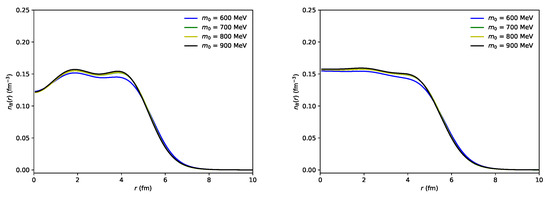
Figure 1.
Nucleon density profile in 112Sn (left) and 126Sn (right) calculated with MeV.
In Figure 2, we present the value of and in 112Sn and 126Sn for different values of the chiral invariant mass. As expected, the value of decreases and increases as , from zero density to the saturation density.
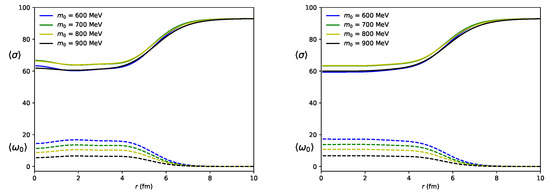
Figure 2.
and in 112Sn (left) and 126Sn (right) with MeV.
The effective neutron and proton masses in 112Sn and 126Sn are shown in Figure 3, where the effective mass is defined as the energy of the nucleon at rest:
As observed in Ref. [67], the neutron–proton mass difference becomes larger in a nucleus with larger isospin asymmetry.
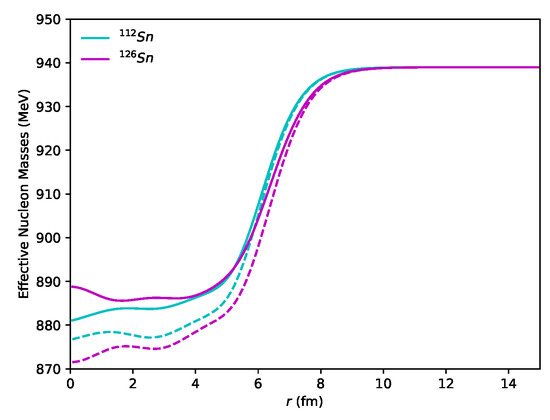
Figure 3.
Neutron and proton effective masses in 112Sn and 126Sn with MeV. Here, solid (dashed) lines are for the neutron (proton).
Now, as in Ref. [67], we compare our results with experiments to check which value of the chiral invariant mass reproduces the experimental results well. In Table 6 and Table 7, we present the binding energies per nucleon and the charge radii as well as the root-mean-square deviation (RMSD) with , 700, 800, 900 MeV for selected nuclei: 16O, 40Ca, 48Ca, 58Ni, 70Ge, 82Se, 92Mo, 112Sn, 126Sn, 138Ba, 154Sm, 170Er, 182W, 202Pb, and 208Pb [67]. It can be seen from Table 6 and Table 7 that the case with MeV has the smallest RMS deviation both in the binding energies and charge radii. Therefore, as concluded in Ref. [67], MeV is preferred by the nuclear properties of selected isotopes.

Table 6.
Binding energy per nucleon and the charge radius () with the parameter set in Table 3 for MeV. The table is taken from Ref. [67].

Table 7.
Binding energy per nucleon and the charge radius () with the parameter set in Table 3 for MeV. The table is taken from Ref. [67].
With MeV, we try to improve our results of nuclear properties. For this, we use the following nuclear matter properties as inputs,
and determine the model parameters again given in Table 8 [67]. With the new parameter set in Table 8, we calculate the properties of selected nuclei and compare our results with experiments and the ones obtained in RCHB with PC-PK1 [75,76] in Table 9. As in Table 9, our results are in quantitative agreement with experiments. As stated in Ref. [67], pairing correlations are not included in our current results, which will be improved in our future publications.

Table 8.
Parameter set with the inputs in Equation (70). All the parameters are dimensionless except .

Table 9.
Binding energy per nucleon and the charge radius () with the parameters in Table 8.
4. Effect of Meson to Nuclear Matter
In the previous sections, we omitted the effect of the meson when we studied nuclear matter and finite nuclei. However, the isovector scalar meson may play an important role in the asymmetric matter, such as neutron star matter and neutron-rich nuclei. In this section, we study the effect of the meson on nuclear properties such as symmetry energy and slope parameter. As we will see, the meson stiffens the matter strongly and causing a large slope parameter . We include also the vector meson mixing interaction to effectively reduce the slope parameter and study the effect of it.
4.1. Dense Nuclear Matter with
To construct the nuclear matter with , we adopt the mean-field approximation by taking
Then, the mean field for M becomes
Now, the potential is written in terms of the meson mean fields as
where the parameters are defined as
In the present model, is taken as a free parameter to examine the effect of and interactions, which are of sub-leading order in the large expansion. Given that the term is suppressed by compared to the term in the large expansion, we assume holds. Consequently, we consider to assess the impact of the sub-leading order six-point interactions on the symmetry energy. By default, we first set . In the end of Section 4.3 and Section 4.4, we investigate the impact of on the results by comparing the cases with .
In the mean-field approximation, the vector meson fields are taken as
according to the rotational symmetry and isospin symmetry. Subsequently, the Lagrangian of the vector mesons is expressed in terms of the mean fields as
with
It is crucial to note that is required to realize in vacuum. To show it, we start from the vector meson potential in vacuum given as
The vacuum expectation values of the vector meson fields are chosen at the stationary point of with minimal energy. The stationary conditions are given by
leading to two distinct stationary points,
Then, the values of potential at stationary points are
In the present model, vanishing vacuum expectation values of the vector meson fields are required at zero density due to the Lorentz-invariance of the vacuum. Consequently, we must require here, such that minimizes the effective potential in vacuum.
Then, the thermodynamic potential for the nucleons is written as
where denotes the parity and the iso-spin of nucleons ( for proton and for neutron). is the effective chemical potential given by
and is the energy of the nucleon defined as , where and are the momentum and the effective mass of the nucleon. The effective mass is given by
We note that the masses of proton and neutron become non-degenerate in the asymmetric matter due to the non-zero mean field of .
The entire thermodynamic potential for hadronic matter is expressed as
where we subtracted the potential at the vacuum
4.2. Determination of Model Parameters
In the present model, there are seven parameters in the meson potential, , , , , , , and , in addition to the meson masses , , , and the pion decay constant . We also have four parameters, , , , and for the couplings of mesons to baryons. As in Section 2, we use the physical values of three masses , , and , together with the pion decay constant as listed in Table 2. In addition, we use the masses of and mesons listed in Table 10 as inputs. Similarly to Section 2, we determine the values of , , and from the saturation properties: the saturation density , the binding energy , and the incompressibility summarized in Table 1, combined with the vacuum condition given in Equation (52). and are determined from the vacuum mass of nucleon and its parity partner . The resultant values are same as those shown in Table 3. Then, the parameters K and are determined from the meson masses and the other parameters as
where and are the masses of and .

Table 10.
Values of masses of and mesons in unit of MeV.
As we stated in the previous subsection, we take for a while. The resultant values of and corresponding to a given are presented in Table 11.

Table 11.
Values of parameters and for several choices of and with .
To demonstrate the effect of (980) on the matter, we consider both the model with vector-meson mixing () and that without the mixing (). In the model without vector meson mixing, parameter is determined from the symmetry energy at the saturation density , while the slope parameter is computed from the model as an output.
Table 12 shows the values of together with . We note that the slope parameters are much larger than the recently accepted value MeV [72]. We also note that the effect of on the value of is larger when we include the meson into the model. The value of with different is shown in Table 13.

Table 12.
The values of and slope parameter in the model without vector meson mixing, for several choices of and with . MeV.

Table 13.
Values of and slope parameter in the model without vector meson mixing, for several choices of and with . MeV.
For making the slope parameter consistent with MeV, we include the vector meson mixing interaction, which allows us to reduce . In the model with vector meson mixing, the parameters and are determined by fitting them to the symmetry energy , as well as the slope parameter . To reproduce the matter for recent accepted value of MeV, we compute our results for –80 MeV. The resultant parameters are shown in Table 14 and Table 15. Here, we only show the results for because the values of the parameters for are similar to the values listed in Table 14 and Table 15.

Table 14.
Values of for several choices of , , with = 0. Vector meson mixing is considered.

Table 15.
Values of for several choices of , , with = 0. Vector meson mixing is considered.
4.3. Effect of to Symmetry Energy in Model without Vector Meson Mixing
The (980) meson should affect the properties of the matter via the asymmetry of the matter. Therefore, we expect that symmetry energy is essential to study the effect of (980) meson to the matter. In the following, we study how the inclusion of the meson affects the symmetry energy.
In the present model, the symmetry energy S() for a given density is expressed as
where is the effective chemical potential for in the symmetric matter, the corresponding Fermi momentum, the mass. In Equation (89), there are three contributions to the symmetry energy: the nucleon contribution, the meson contribution, and the meson contribution.
The nucleon contribution is given by
which arises from the effective kinetic contribution of nucleons. Figure 4 shows for –900 MeV with , 240 MeV. It is observed that increases with density, as the effective kinetic energy of nucleons rises with density. Additionally, it is noted that is larger for smaller due to the stiffening of matter for smaller . It can be also seen that is larger for larger . However, the change in has little effect on . We note that, since arises from the effective kinetic contribution of a nucleon, is not affected by the inclusion of meson.
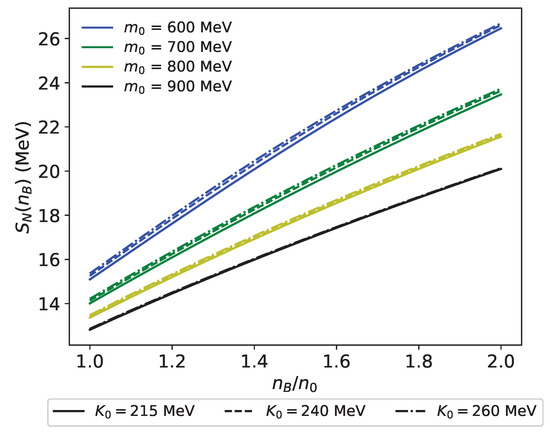
Figure 4.
Nucleon contribution for –900 MeV. Solid, dashed, and dash-dot curves represent with MeV, respectively.
The contribution from the meson is expressed as
Figure 5 shows computed in the present model. We note that is negative and, thus, reduces the total symmetry energy . This is because is always positive, as shown in Figure 6. Intuitively, this can be understood from the dependence of on the mean field a given in Equation (85). If we vary the mean field a, will also change correspondingly. However, the effective chemical potential does not depend on the mean field a directly, as we can see from Equation (84). This change in the effective mass due to the mean field a leads to a change in the momentum of the neutron . When is increased for a fixed , the density of the neutron and, thus, the momentum is decreased. Accordingly, the effective mass of the neutron is increasing as increase, causing a positive . Therefore, the (980) meson contribution reduces the total symmetry energy in the present model. We also find that the (980) effect on the symmetry energy is stronger for smaller . This is because the coupling constants of meson to the nucleon, and , are larger for smaller , as shown in Table 3. As a result, the symmetry energy becomes larger by meson more when is smaller. In addition, we note that the effect on the symmetry energy is decreasing as the density increases since decreases. We also observe that has a larger effect on due to the effect of on the coupling constants of meson, as indicated in Table 3 and Table 11. Since the effect of the meson becomes smaller as the density increases, becomes less negative and spreads at higher densities. We also note that the difference of with different becomes smaller as increase due to a weaker meson effect. Notice that this contribution does not exist in models without the meson.
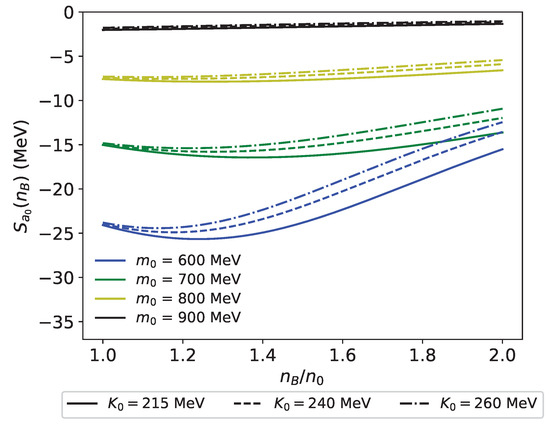
Figure 5.
meson contribution to the symmetry energy for –900 MeV. Solid, dashed, and dash-dot curves represent with MeV, respectively.
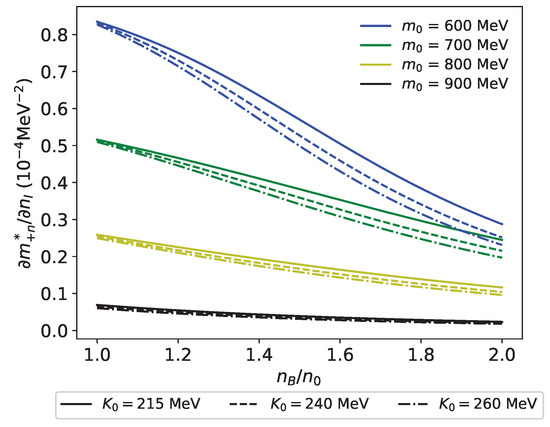
Figure 6.
for –900 MeV. Solid, dashed, and dash-dot curves represent with MeV, respectively.
The meson contribution is given by
This shows that the contribution is always positive and, thus, provides repulsive force to the matter. Figure 7 shows the behavior of for –900 MeV with , 240 MeV. It is noteworthy that is directly proportional to the baryon density , rendering it an increasing function with density. We also note that exhibits larger values for heavier . This is understood as follows: at the saturation density, the symmetry energy is fixed to be 31 MeV. Since the total symmetry energy is given by Equation (89), a larger corresponds to a smaller and, consequently, a larger . This larger yields a larger coupling constant for larger . As a result, is larger for larger at density higher than the saturation density. Figure 7 also shows that has little effect on . We note that and is determined from . Then, we obtain from , and . Since and are larger as increases, these two contributions compensate with to maintain MeV at . Thus, is smaller as increases, which is opposite to and . We also observe that the value of for the present model is very large compared with the value of model without meson. This is because the meson coupling is much larger in the present model due to the attractive interaction of (980) when comparing to the model without meson.
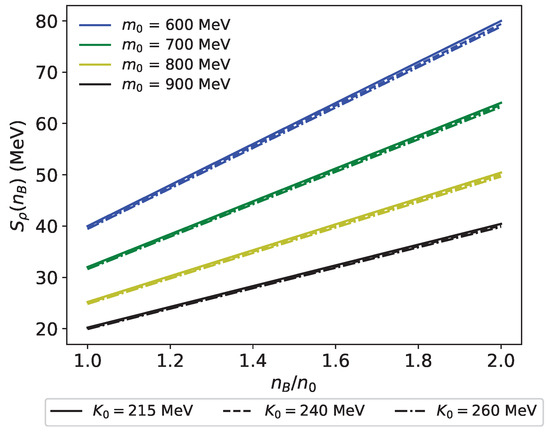
Figure 7.
meson contribution in model for –900 MeV and . Solid, dashed, and dash-dot curves represent with MeV, respectively.
Based on the above properties of three contributions, the symmetry energy can be understood as a result of the competition between the repulsive meson interaction and the attractive (980) interaction, in addition to the kinetic contribution from the nucleons. On the other hand, in the model without meson, only repulsive contributions exist. Since the symmetry energy at the saturation density is fixed as MeV in the both models with and without meson, the meson coupling is strengthened by the existence of the attractive contribution in the model with comparing to the model without . Actually, it is clear from Table 3 and Table 12 that is larger in the model than in the no- model for a fixed . Figure 8 shows the symmetry energy for –900 MeV and MeV, with the results of the model with meson and without meson are shown in solid curve and dashed curve, respectively. We observe that the symmetry energy is indeed stiffened by the existence of (980). Furthermore, the difference of the symmetry energy between the models is larger for smaller because the coupling to the meson is stronger, as indicated by Table 3. At , the symmetry energy is enlarged by meson as large as ∼60% or more in the present model depending on the choice of input parameters.
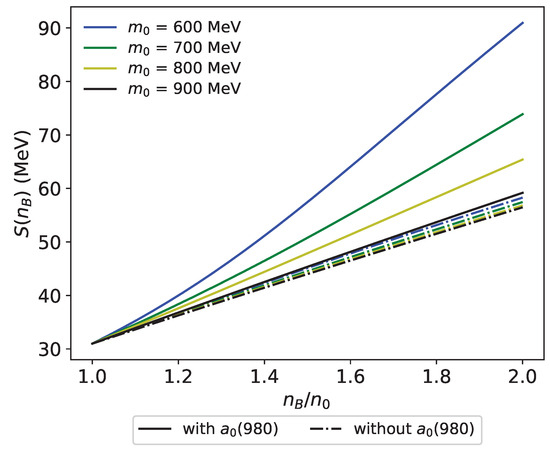
Figure 8.
Symmetry energy for –900 MeV, MeV, and . Solid curves represent the of the model, including with = 0, while the dash-dot curves show the results of the model without .
In Figure 9, we compare the total symmetry energy with different choices of , and the results show that the symmetry energy is not sensitive to the value of because the effect of to the total symmetry energy is canceled by the compensation between , , and .

Figure 9.
Symmetry energy for –900 MeV, , with different choices of compared. Solid, dashed, and dash-dot curves represent with MeV, respectively.
The effect of to the total symmetry energy is also studied. Figure 10 shows the difference of the symmetry energy . We note that has large impact to the symmetry energy, since affects the determination of . As expected, larger results in larger .
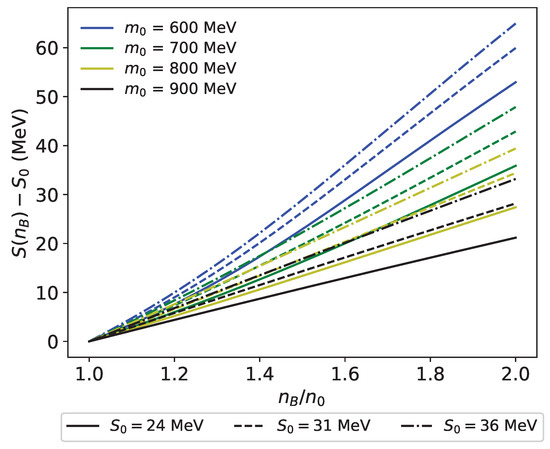
Figure 10.
Difference of the symmetry energy in model for –900 MeV and . MeV. Solid, dashed, and dash-dot curves represent with MeV, respectively.
In addition, we investigate the effect of higher-order terms in the large expansion for the six-point interaction on the symmetry energy by taking . The results of the symmetry energies with different values of are shown in Figure 11. We can see that the difference between the symmetry energies for models with the same is small, which indicates that the effect of on the symmetry energy is small. Notice also that the difference becomes smaller for larger , due to a smaller (980) effect.
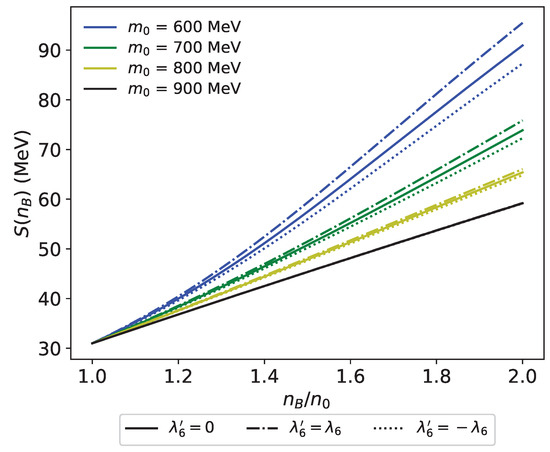
Figure 11.
Symmetry energy for –900 MeV and MeV, with the effect of compared. Solid, dash-dot, and dotted curves show the with , and , respectively.
4.4. Symmetry Energy of Model with Vector Meson Mixing
As we see from the previous sections, PDM predicts a rather large slope parameter , which does not seem compatible with the recently accepted value of MeV. In particular, the model with meson predicts a very large , as well as the symmetry energy at density . In order to soften the matter to reproduce the accepted value of , we include the - vector mixing term to reduce the stiffness of the matter in our model. In this section, we study the symmetry energy with vector meson mixing interaction.
In the current model, the symmetry energy for a given density is expressed as follows:
Similarly to Equation (89), the symmetry energy is divided into sum of three contributions: the nucleon contribution , meson contribution , and meson contribution . Notably, the nucleon contribution and meson contribution are unaffected by the vector meson mixing, since their related parameters are determined from symmetric matter properties. Therefore, the results of and are the same as given in Figure 4 and Figure 5.
On the other hand, the meson contribution receives a correction from the vector meson mixing interaction as
where the meson appears to have an effective mass exhibiting density-dependence. We note that the meson influences the symmetry energy through in the denominator. Given that , as shown in Section 4.1, the - mixing term always reduces the symmetry energy. The density dependence of is illustrated in Figure 12. It is observed that increases with rising in the low-density region, but decreases in the high-density region. This is understood as follows: in the low-density region where , the density dependence of is primarily determined by the pre-factor . In the high density region, on the other hand, the denominator is dominated by , which leads to . As a result, the behavior of smoothly transforms from . We also observe that the value of has larger influence to due to the vector meson mixing. receives a extra correction from coming from the vector meson mixing as we read from Equation (94). Since the repulsive coupling increase as becomes larger, is smaller with larger and further spread at higher densities.
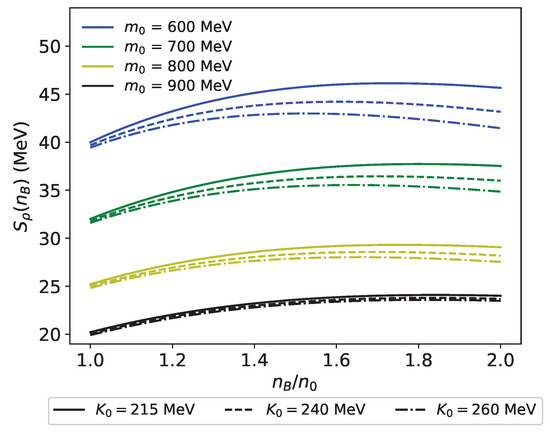
Figure 12.
meson contribution in model for –900 MeV, , and MeV. Solid, dashed, and dash-dot curves represent with MeV, respectively.
Figure 13 shows the total symmetry energy for –900 MeV and MeV. For comparison, we also show the results of the no- model with vector meson mixing by dashed curves, as retrieved from Ref. [66]. We note that when the vector meson mixing is included, the slope of the symmetry energy is reduced in the high density region. We also observe that, in most cases, the symmetry energy is stiffened by the existence of (980), and the difference of the symmetry energy between two models is larger for smaller . In the case of large , such as MeV where the (980) meson effect is small, the softening effect of term overrides the stiffening effect from the (980) meson. As a result, the symmetry energy is reduced even after the inclusion of meson. A similar reduction in the symmetry energy in the intermediate density region was also reported in Ref. [56], which includes both the scalar meson mixing and the vector meson mixing interactions in an RMF model with the presence of isovector-scalar meson.
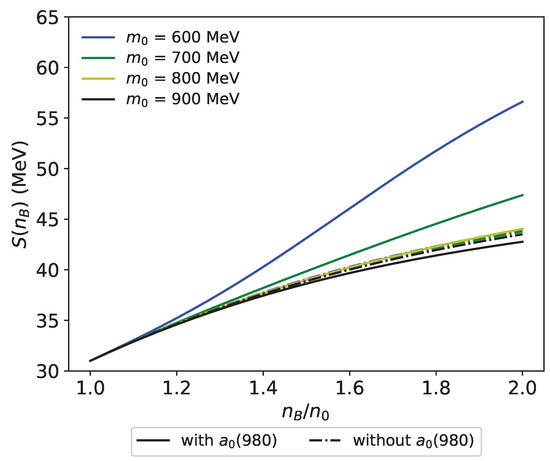
Figure 13.
Symmetry energy in model with vector meson mixing for –900 MeV, , MeV, and MeV. Solid curves represent the of the model, including with = 0, while the dash-dot curves show the results of the model without .
In Figure 14, we study the dependence of the symmetry energy. Similarly to the models introduced in the previous sections, has very little effect to the symmetry energy. Due to the extra correction of the vector meson mixing to , the effect of is further suppressed due to the compensation of the effect of to , , and .
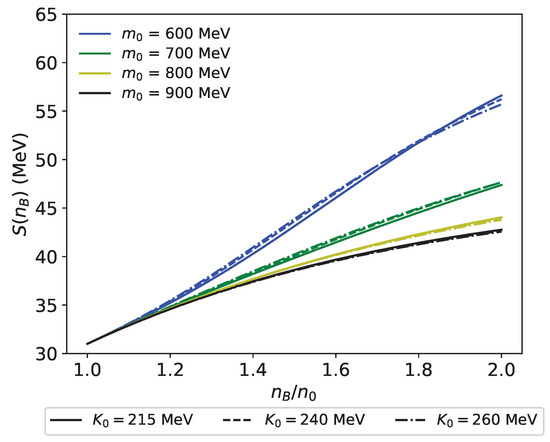
Figure 14.
dependence of the symmetry energy in the model with vector meson mixing for , and MeV. Solid, dashed, and dash-dot curves represent with MeV, respectively.
In particular, the results of = 700 MeV and = 60 MeV from the present model is compared to the results of other mean field models such as FSU-6.7 [56] and B. Liu et al. [63], and density dependent RMF models such as DD-ME [65] in Figure 15. We observe that the vector meson mixing reduces the symmetry energy at high density similarly to the model with density dependent couplings without vector meson mixing interaction. In addition, our model without vector meson mixing predicts a large symmetry energy similarly to the RMF model without vector meson mixing, while the symmetry energy in models with vector meson mixing is effectively reduced.
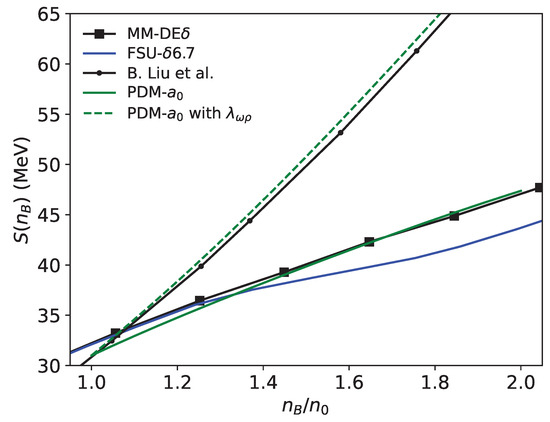
Figure 15.
Comparison of the symmetry energy of the present model with the ones of other models. The results from density dependent RMF model DD-ME [65] and RMF model from B. Liu et al. [63] and FSU-6.7 [56] are compared. The results from present model shown in the figure takes the typical value of MeV, , MeV, and MeV for result with vector meson mixing.
Finally, we compare the symmetry energy in the models with different in Figure 16. As expected, the effect to symmetry energy is smaller than the effect of , because interactions are of sub-leading order in large expansion.
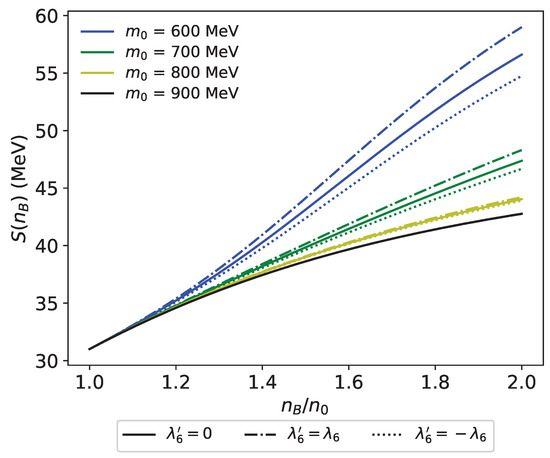
Figure 16.
Symmetry energy for –900 MeV, MeV, and MeV with the effect of compared. Solid, dash-dot, and dotted curves show the with .
5. Summary
In this review, we summarized the recent studies on infinite nuclear matter and finite nuclei based on parity doublet models (PDMs). We first introduced a PDM, which is constructed in Ref. [19]. Under the mean field approximation, the nuclear properties such as slope parameter and symmetry energy were computed. In particular, we observed that the slope parameter is relatively larger than the recently accepted value MeV [72]. We also investigated the impact of the value of to the model. We found that the value of has little impact to the matter properties, such as the symmetry energy and slope parameter in the model without meson. We also studied the effect of to the slope parameter . We find that the value of will affect the value of significantly.
We then considered the properties of some stable nuclei in the mean field approximation to pin down the value of the chiral invariant mass preferred by the nuclear binding energies and charge radii. We found that our results are closest to the experiments when we take MeV. We also calculated the neutron and proton masses in a nucleus and observed, as expected, that the neutron–proton mass difference becomes larger in an isospin asymmetric nucleus.
Then, we studied the effect of isovector scalar meson to the matter. The isovector scalar meson provides the attractive force in the isovector channel, and is important in the asymmetric matter. We found that the inclusion of has a very strong influence on the symmetry energy and slope parameter. We observed that the symmetry energy at densities is largely enhanced by the existence of . By analyzing the different contributions to the symmetry energy, we concluded that this enhancement is originated from the strengthening of the meson coupling . The meson generates the attractive force in the isovector channel, which requires the repulsive force from meson to be larger for reproducing the saturation property. As a result, a larger repulsive interaction increases the symmetry energy at densities . However, we also observed that this stiffening of nuclear matter produces a large slope parameter that is much larger than the recently accepted value suggested by other studies. Therefore, we introduced the - mixing interaction to reduce the slope parameter in the model. It was found that the symmetry energy at density is reduced after the inclusion of - mixing interaction. Furthermore, we observed that the - mixing interaction modifies the density dependence of the symmetry energy at density . We also observed that the value of has relatively large impact on the contribution to symmetry energy and due to the effect of to the meson. However, similarly to the case of model without the meson, has limited effect to the total symmetry energy because of the compensation of the effect between , , and . The effect is further suppressed when vector meson mixing effect is included. We also investigated the effect of to the total symmetry energy. As expected, the value of has large impact to the meson coupling and thus the symmetry energy. There are also some microscopic nuclear force models in, e.g., Refs. [77,78,79]. It would be also interesting to compare the result of the present model to the results of these models.
We expect that future experiments on the study of symmetry energy at higher densities will provide further constraints on the chiral invariant mass of the nucleon. We also expect that will have a significant influence on asymmetric nuclei. It would be interesting to study finite nuclei using the extended PDM including the meson, which may give new information to constraints on the chiral invariant mass of the nucleon and the behavior of nucleon mass in dense matter. We leave this as future project.
Author Contributions
Writing—original draft preparation, Y.-K.K., Y.K. and M.H.; writing—review and editing, Y.-K.K., Y.K. and M.H. All authors have read and agreed to the published version of the manuscript.
Funding
This work was supported in part by the Institute for Basic Science (IBS-R031-D1) (YK), JSPS KAKENHI Grant Nos. 20K03927, 23H05439 and 24K07045 (MH).
Data Availability Statement
Data is contained within the article.
Acknowledgments
We thank Jie Meng for providing us the RCHB code.
Conflicts of Interest
The authors declare no conflicts of interest.
References
- Aarts, G.; Allton, C.; Hands, S.; Jäger, B.; Praki, C.; Skullerud, J.I. Nucleons and parity doubling across the deconfinement transition. Phys. Rev. D 2015, 92, 014503. [Google Scholar] [CrossRef]
- Aarts, G.; Allton, C.; De Boni, D.; Hands, S.; Jäger, B.; Praki, C.; Skullerud, J.I. Light baryons below and above the deconfinement transition: Medium effects and parity doubling. J. High Energy Phys. 2017, 2017, 34. [Google Scholar] [CrossRef]
- DeTar, C.; Kunihiro, T. Linear sigma model with parity doubling. Phys. Rev. D 1989, 39, 2805–2808. [Google Scholar] [CrossRef]
- Kim, J.; Lee, S.H. Masses of hadrons in the chiral symmetry restored vacuum. Phys. Rev. D 2022, 105, 014014. [Google Scholar] [CrossRef]
- Jido, D.; Oka, M.; Hosaka, A. Chiral Symmetry of Baryons. Prog. Theor. Phys. 2001, 106, 873–908. [Google Scholar] [CrossRef]
- Yamazaki, T.; Harada, M. Chiral partner structure of light nucleons in an extended parity doublet model. Phys. Rev. D 2019, 99, 034012. [Google Scholar] [CrossRef]
- Hatsuda, T.; Prakash, M. Parity Doubling of the Nucleon and First Order Chiral Transition in Dense Matter. Phys. Lett. B 1989, 224, 11–15. [Google Scholar] [CrossRef]
- Zschiesche, D.; Tolos, L.; Schaffner-Bielich, J.; Pisarski, R.D. Cold, dense nuclear matter in a SU(2) parity doublet model. Phys. Rev. C 2007, 75, 055202. [Google Scholar] [CrossRef]
- Dexheimer, V.; Schramm, S.; Zschiesche, D. Nuclear matter and neutron stars in a parity doublet model. Phys. Rev. C 2008, 77, 025803. [Google Scholar] [CrossRef]
- Dexheimer, V.; Pagliara, G.; Tolos, L.; Schaffner-Bielich, J.; Schramm, S. Neutron stars within the SU(2) parity doublet model. Eur. Phys. J. A 2008, 38, 105–113. [Google Scholar] [CrossRef]
- Sasaki, C.; Mishustin, I. Thermodynamics of dense hadronic matter in a parity doublet model. Phys. Rev. C 2010, 82, 035204. [Google Scholar] [CrossRef]
- Sasaki, C.; Lee, H.K.; Paeng, W.G.; Rho, M. Conformal anomaly and the vector coupling in dense matter. Phys. Rev. D 2011, 84, 034011. [Google Scholar] [CrossRef]
- Gallas, S.; Giacosa, F.; Pagliara, G. Nuclear matter within a dilatation-invariant parity doublet model: The role of the tetraquark at nonzero density. Nucl. Phys. A 2011, 872, 13–24. [Google Scholar] [CrossRef]
- Paeng, W.G.; Lee, H.K.; Rho, M.; Sasaki, C. Dilaton-Limit Fixed Point in Hidden Local Symmetric Parity Doublet Model. Phys. Rev. D 2012, 85, 054022. [Google Scholar] [CrossRef]
- Steinheimer, J.; Schramm, S.; Stocker, H. The hadronic SU(3) Parity Doublet Model for Dense Matter, its extension to quarks and the strange equation of state. Phys. Rev. C 2011, 84, 045208. [Google Scholar] [CrossRef]
- Dexheimer, V.; Steinheimer, J.; Negreiros, R.; Schramm, S. Hybrid Stars in an SU(3) parity doublet model. Phys. Rev. C 2013, 87, 015804. [Google Scholar] [CrossRef]
- Paeng, W.G.; Lee, H.K.; Rho, M.; Sasaki, C. Interplay between ω-nucleon interaction and nucleon mass in dense baryonic matter. Phys. Rev. D 2013, 88, 105019. [Google Scholar] [CrossRef]
- Benic, S.; Mishustin, I.; Sasaki, C. Effective model for the QCD phase transitions at finite baryon density. Phys. Rev. D 2015, 91, 125034. [Google Scholar] [CrossRef]
- Motohiro, Y.; Kim, Y.; Harada, M. Asymmetric nuclear matter in a parity doublet model with hidden local symmetry. Phys. Rev. C 2015, 92, 025201, Erratum in Phys. Rev. C 2017, 95, 059903. [Google Scholar] [CrossRef]
- Mukherjee, A.; Steinheimer, J.; Schramm, S. Higher-order baryon number susceptibilities: Interplay between the chiral and the nuclear liquid-gas transitions. Phys. Rev. C 2017, 96, 025205. [Google Scholar] [CrossRef]
- Suenaga, D. Examination of N*(1535) as a probe to observe the partial restoration of chiral symmetry in nuclear matter. Phys. Rev. C 2018, 97, 045203. [Google Scholar] [CrossRef]
- Takeda, Y.; Kim, Y.; Harada, M. Catalysis of partial chiral symmetry restoration by Δ matter. Phys. Rev. C 2018, 97, 065202. [Google Scholar] [CrossRef]
- Mukherjee, A.; Schramm, S.; Steinheimer, J.; Dexheimer, V. The application of the Quark-Hadron Chiral Parity-Doublet Model to neutron star matter. Astron. Astrophys. 2017, 608, A110. [Google Scholar] [CrossRef]
- Paeng, W.G.; Kuo, T.T.S.; Lee, H.K.; Ma, Y.L.; Rho, M. Scale-invariant hidden local symmetry, topology change, and dense baryonic matter. II. Phys. Rev. D 2017, 96, 014031. [Google Scholar] [CrossRef]
- Marczenko, M.; Sasaki, C. Net-baryon number fluctuations in the Hybrid Quark-Meson-Nucleon model at finite density. Phys. Rev. D 2018, 97, 036011. [Google Scholar] [CrossRef]
- Abuki, H.; Takeda, Y.; Harada, M. Dual chiral density waves in nuclear matter. Epj Web Conf. 2018, 192, 00020. [Google Scholar] [CrossRef][Green Version]
- Marczenko, M.; Blaschke, D.; Redlich, K.; Sasaki, C. Chiral symmetry restoration by parity doubling and the structure of neutron stars. Phys. Rev. D 2018, 98, 103021. [Google Scholar] [CrossRef]
- Marczenko, M.; Blaschke, D.; Redlich, K.; Sasaki, C. Parity Doubling and the Dense Matter Phase Diagram under Constraints from Multi-Messenger Astronomy. Universe 2019, 5, 180. [Google Scholar] [CrossRef]
- Yamazaki, T.; Harada, M. Constraint to chiral invariant masses of nucleons from GW170817 in an extended parity doublet model. Phys. Rev. C 2019, 100, 025205. [Google Scholar] [CrossRef]
- Harada, M.; Yamazaki, T. Charmed Mesons in Nuclear Matter Based on Chiral Effective Models. Jps Conf. Proc. 2019, 26, 024001. [Google Scholar] [CrossRef]
- Marczenko, M.; Blaschke, D.; Redlich, K.; Sasaki, C. Toward a unified equation of state for multi-messenger astronomy. Astron. Astrophys. 2020, 643, A82. [Google Scholar] [CrossRef]
- Harada, M. Dense nuclear matter based on a chiral model with parity doublet structure. In Proceedings of the 18th International Conference on Hadron Spectroscopy and Structure, Guilin, China, 16–21 August 2019. [Google Scholar] [CrossRef]
- Minamikawa, T.; Kojo, T.; Harada, M. Quark-hadron crossover equations of state for neutron stars: Constraining the chiral invariant mass in a parity doublet model. Phys. Rev. C 2021, 103, 045205. [Google Scholar] [CrossRef]
- Marczenko, M.; Redlich, K.; Sasaki, C. Reconciling Multi-messenger Constraints with Chiral Symmetry Restoration. Astrophys. J. Lett. 2022, 925, L23. [Google Scholar] [CrossRef]
- Minamikawa, T.; Kojo, T.; Harada, M. Chiral condensates for neutron stars in hadron-quark crossover: From a parity doublet nucleon model to a Nambu–Jona-Lasinio quark model. Phys. Rev. C 2021, 104, 065201. [Google Scholar] [CrossRef]
- Marczenko, M.; Redlich, K.; Sasaki, C. Chiral symmetry restoration and Δ matter formation in neutron stars. Phys. Rev. D 2022, 105, 103009. [Google Scholar] [CrossRef]
- Gao, B.; Minamikawa, T.; Kojo, T.; Harada, M. Impacts of the U(1)A anomaly on nuclear and neutron star equation of state based on a parity doublet model. Phys. Rev. C 2022, 106, 065205. [Google Scholar] [CrossRef]
- Minamikawa, T.; Gao, B.; Kojo, T.; Harada, M. Chiral restoration of nucleons in neutron star matter: Studies based on a parity doublet model. Symmetry 2023, 15, 745. [Google Scholar] [CrossRef]
- Marczenko, M.; Redlich, K.; Sasaki, C. Fluctuations near the liquid-gas and chiral phase transitions in hadronic matter. Phys. Rev. D 2023, 107, 054046. [Google Scholar] [CrossRef]
- Gao, B.; Yan, Y.; Harada, M. Reconciling constraints from the supernova remnant HESS J1731-347 with the parity doublet model. Phys. Rev. C 2024, 109, 065807. [Google Scholar] [CrossRef]
- Baym, G.; Hatsuda, T.; Kojo, T.; Powell, P.D.; Song, Y.; Takatsuka, T. From hadrons to quarks in neutron stars: A review. Rep. Prog. Phys. 2018, 81, 056902. [Google Scholar] [CrossRef]
- Baym, G.; Furusawa, S.; Hatsuda, T.; Kojo, T.; Togashi, H. New Neutron Star Equation of State with Quark–Hadron Crossover. Astrophys. J. 2019, 885, 42. [Google Scholar] [CrossRef]
- Cromartie, H.T.; Fonseca, E.; Ransom, S.M.; Demorest, P.B.; Arzoumanian, Z.; Blumer, H.; Brook, P.R.; DeCesar, M.E.; Dolch, T.; Ellis, J.A.; et al. Relativistic Shapiro delay measurements of an extremely massive millisecond pulsar. Nat. Astron. 2019, 4, 72–76. [Google Scholar] [CrossRef]
- Abbott, B.P.; Abbott, R.; Abbott, D.; Acernese, F.; Ackley, K.; Adams, C.; Adams, T.; Addesso, P.; Adhikari, X.; Adya, B.; et al. GW170817: Observation of Gravitational Waves from a Binary Neutron Star Inspiral. Phys. Rev. Lett. 2017, 119, 161101. [Google Scholar] [CrossRef]
- Abbott, B.P. Multi-messenger Observations of a Binary Neutron Star Merger. Astrophys. J. Lett. 2017, 848, L12. [Google Scholar] [CrossRef]
- Abbott, B.P.; Abbott, R.; Abbott, D.; Acernese, F.; Ackley, K.; Adams, C.; Adams, T.; Addesso, P.; Adhikari, X.; Adya, B.; et al. GW170817: Measurements of neutron star radii and equation of state. Phys. Rev. Lett. 2018, 121, 161101. [Google Scholar] [CrossRef]
- Miller, M.; Lamb, F.K.; Dittmann, A.J.; Bogdanov, S.; Arzoumanian, Z.; Gendreau, K.C.; Guillot, S.; Harding, A.K.; Ho, W.C.G.; Lattimer, J.M.; et al. PSR J0030+0451 Mass and Radius from NICER Data and Implications for the Properties of Neutron Star Matter. Astrophys. J. Lett. 2019, 887, L24. [Google Scholar] [CrossRef]
- Riley, T.E.; Watts, A.L.; Bogdanov, S.; Ray, P.S.; Ludlam, R.M.; Guillot, S.; Arzoumanian, Z.; Baker, C.L.; Bilous, A.V.; Chakrabarty, D.; et al. A NICER View of PSR J0030+0451: Millisecond Pulsar Parameter Estimation. Astrophys. J. Lett. 2019, 887, L21. [Google Scholar] [CrossRef]
- Fonseca, E.; Cromartie, H.T.; Pennucci, T.T.; Ray, P.S.; Kirichenko, A.Y.; Ransom, S.M.; Demorest, P.B.; Stairs, I.H.; Arzoumanian, Z.; Guillemot, L.; et al. Refined Mass and Geometric Measurements of the High-mass PSR J0740+6620. Astrophys. J. Lett. 2021, 915, L12. [Google Scholar] [CrossRef]
- De, S.; Finstad, D.; Lattimer, J.M.; Brown, D.A.; Berger, E.; Biwer, C.M. Tidal Deformabilities and Radii of Neutron Stars from the Observation of GW170817. Phys. Rev. Lett. 2018, 121, 091102, Erratum in Phys. Rev. Lett. 2018, 121, 259902. [Google Scholar] [CrossRef]
- Radice, D.; Perego, A.; Zappa, F.; Bernuzzi, S. GW170817: Joint Constraint on the Neutron Star Equation of State from Multimessenger Observations. Astrophys. J. Lett. 2018, 852, L29. [Google Scholar] [CrossRef]
- Doroshenko, V.; Suleimanov, V.; Pühlhofer, G.; Santangelo, A. A strangely light neutron star within a supernova remnant. Nat. Astron. 2022, 6, 1444–1451. [Google Scholar] [CrossRef]
- Kubis, S.; Kutschera, M. Nuclear matter in relativistic mean field theory with isovector scalar meson. Phys. Lett. B 1997, 399, 191–195. [Google Scholar] [CrossRef]
- Kubis, S.; Kutschera, M.; Stachniewicz, S. Neutron Stars in Relativistic Mean Field Theory with Isovector Scalar Meson. arXiv 1998, arXiv:astro-ph/9802303. [Google Scholar] [CrossRef]
- Miyatsu, T.; Cheoun, M.K.; Saito, K. Asymmetric Nuclear Matter in Relativistic Mean-field Models with Isoscalar- and Isovector-meson Mixing. Astrophys. J. 2022, 929, 82. [Google Scholar] [CrossRef]
- Li, F.; Cai, B.J.; Zhou, Y.; Jiang, W.Z.; Chen, L.W. Effects of Isoscalar- and Isovector-scalar Meson Mixing on Neutron Star Structure. Astrophys. J. 2022, 929, 183. [Google Scholar] [CrossRef]
- Miyatsu, T.; Cheoun, M.K.; Kim, K.; Saito, K. Massive neutron stars with small radii in relativistic mean-field models optimized to nuclear ground states. arXiv 2022, arXiv:2209.02861. [Google Scholar] [CrossRef]
- Thakur, V.; Kumar, R.; Kumar, P.; Kumar, V.; Kumar, M.; Mondal, C.; Agrawal, B.K.; Dhiman, S.K. Effects of an isovector scalar meson on the equation of state of dense matter within a relativistic mean field model. Phys. Rev. C 2022, 106, 045806. [Google Scholar] [CrossRef]
- Liu, B.; Guo, H.; Toro, M.D.; Greco, V. Neutron stars with isovector scalar correlations. Eur. Phys. J. A 2005, 25, 293–298. [Google Scholar] [CrossRef][Green Version]
- Rabhi, A.; Providência, C.; Providência, J.D. Effect of the δ meson on the instabilities of nuclear matter under strong magnetic fields. Phys. Rev. C 2009, 80, 025806. [Google Scholar] [CrossRef]
- Gaitanos, T.; Toro, M.D.; Typel, S.; Baran, V.; Fuchs, C.; Greco, V.; Wolter, H. On the Lorentz structure of the symmetry energy. Nucl. Phys. A 2004, 732, 24–48. [Google Scholar] [CrossRef]
- Greco, V.; Colonna, M.; Di Toro, M.; Matera, F. Collective modes of asymmetric nuclear matter in quantum hadrodynamics. Phys. Rev. C 2003, 67, 015203. [Google Scholar] [CrossRef]
- Liu, B.; Greco, V.; Baran, V.; Colonna, M.; Di Toro, M. Asymmetric nuclear matter: The role of the isovector scalar channel. Phys. Rev. C 2002, 65, 045201. [Google Scholar] [CrossRef]
- Wang, S.; Zhang, H.F.; Dong, J.M. Neutron star properties in density-dependent relativistic mean field theory with consideration of an isovector scalar meson. Phys. Rev. C 2014, 90, 055801. [Google Scholar] [CrossRef]
- Roca-Maza, X.; Viñas, X.; Centelles, M.; Ring, P.; Schuck, P. Relativistic mean-field interaction with density-dependent meson-nucleon vertices based on microscopical calculations. Phys. Rev. C 2011, 84, 054309. [Google Scholar] [CrossRef]
- Kong, Y.K.; Minamikawa, T.; Harada, M. Neutron star matter based on a parity doublet model including the a0(980) meson. Phys. Rev. C 2023, 108, 055206. [Google Scholar] [CrossRef]
- Mun, M.H.; Shin, I.J.; Paeng, W.G.; Harada, M.; Kim, Y. Nuclear structure in parity doublet model. Eur. Phys. J. A 2023, 59, 149. [Google Scholar] [CrossRef]
- Meng, J.; Toki, H.; Zhou, S.G.; Zhang, S.Q.; Long, W.H.; Geng, L.S. Relativistic Continuum Hartree Bogoliubov theory for ground state properties of exotic nuclei. Prog. Part. Nucl. Phys. 2006, 57, 470–563. [Google Scholar] [CrossRef]
- Bando, M.; Kugo, T.; Uehara, S.; Yamawaki, K.; Yanagida, T. Is the ρ Meson a Dynamical Gauge Boson of Hidden Local Symmetry? Phys. Rev. Lett. 1985, 54, 1215–1218. [Google Scholar] [CrossRef]
- Bando, M.; Kugo, T.; Yamawaki, K. Nonlinear Realization and Hidden Local Symmetries. Phys. Rept. 1988, 164, 217–314. [Google Scholar] [CrossRef]
- Harada, M.; Yamawaki, K. Hidden local symmetry at loop: A New perspective of composite gauge boson and chiral phase transition. Phys. Rept. 2003, 381, 1–233. [Google Scholar] [CrossRef]
- Li, B.A.; Cai, B.J.; Xie, W.J.; Zhang, N.B. Progress in Constraining Nuclear Symmetry Energy Using Neutron Star Observables Since GW170817. Universe 2021, 7, 182. [Google Scholar] [CrossRef]
- Garg, U.; Colò, G. The compression-mode giant resonances and nuclear incompressibility. Prog. Part. Nucl. Phys. 2018, 101, 55–95. [Google Scholar] [CrossRef]
- Sunardi, A.; Sulaksono, A. Nuclear bubble in Sn isotope within modified relativistic mean field. AIP Conf. Proc. 2018, 2023, 020007. [Google Scholar] [CrossRef]
- Zhao, P.W.; Li, Z.P.; Yao, J.M.; Meng, J. New parametrization for the nuclear covariant energy density functional with point-coupling interaction. Phys. Rev. C 2010, 82, 054319. [Google Scholar] [CrossRef]
- Xia, X.W.; Lim, Y.; Zhao, P.W.; Liang, H.Z.; Qu, X.Y.; Chen, Y.; Liu, H.; Zhang, L.F.; Zhang, S.Q.; Kim, Y.; et al. The limits of the nuclear landscape explored by the relativistic continuum Hartree–Bogoliubov theory. Atom. Data Nucl. Data Tabl. 2018, 121–122, 1–215. [Google Scholar] [CrossRef]
- Coraggio, L.; Holt, J.W.; Itaco, N.; Machleidt, R.; Sammarruca, F. Reduced regulator dependence of neutron-matter predictions with perturbative chiral interactions. Phys. Rev. C 2013, 87, 014322. [Google Scholar] [CrossRef]
- Entem, D.R.; Machleidt, R. Accurate charge-dependent nucleon-nucleon potential at fourth order of chiral perturbation theory. Phys. Rev. C 2003, 68, 041001. [Google Scholar] [CrossRef]
- Lim, Y.; Holt, J.W. Structure of neutron star crusts from new Skyrme effective interactions constrained by chiral effective field theory. Phys. Rev. C 2017, 95, 065805. [Google Scholar] [CrossRef]
Disclaimer/Publisher’s Note: The statements, opinions and data contained in all publications are solely those of the individual author(s) and contributor(s) and not of MDPI and/or the editor(s). MDPI and/or the editor(s) disclaim responsibility for any injury to people or property resulting from any ideas, methods, instructions or products referred to in the content. |
© 2024 by the authors. Licensee MDPI, Basel, Switzerland. This article is an open access article distributed under the terms and conditions of the Creative Commons Attribution (CC BY) license (https://creativecommons.org/licenses/by/4.0/).